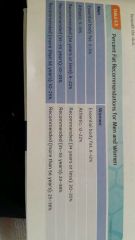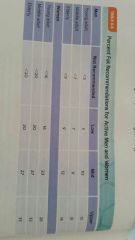![]()
![]()
![]()
Use LEFT and RIGHT arrow keys to navigate between flashcards;
Use UP and DOWN arrow keys to flip the card;
H to show hint;
A reads text to speech;
58 Cards in this Set
- Front
- Back
|
how many US adults engage in regular leisure-time physical activity
|
31%
|
|
|
what approach does physical activity guidlines for americans follow in order to prevent risks?
|
start low and go slow
|
|
|
what is one thing personal trainers can do to make sure that the potential benefits outweigh the the potential risks?
|
complete a preparticipation health or medical screening questionnaire with each individual client
|
|
|
what else must a personal trainer do before starting an exercise program with client
|
determine which fitness or health assesments need to be taken
understanding clients goals, needs and abilities(structurally and functionally) |
|
|
benefits of fitness assesments
|
●helps determine the current health and fitness level of client
●helps determine a clients basline fitness level, allowing you to recommend specific exercises ●ongoing way to communicate info between the personal trainer and client ●allows fitness goals to be monitored consistently and evaluated to make sure clients goals are achieved |
|
|
guidelines for health and fitness professionals Do's
|
obtain exercise or health guidelines from physician, dietician, physical therapist
●refer clients to medical practitioners and design individual, systematic, progressive exercise programs ●provide info on healthy eating refer to dietician ●use exercise to help improve overall health ●provide post rehabilitation service ● act as a coach |
|
|
personal trainers primary responsibility?
|
provide safe and effective exercise and instruction to help clients successfully attain their personal health and wellness goals
|
|
|
what does a fitness assesment provide?
|
●preparticipation health screening
●heart rate ●blood pressure ●height ●weight ●measurements ●health fitness test |
|
|
what are the two components of a fitness assesment?
|
subjective info
onjective info |
|
|
what is the subjective component of a fitness assesment?
|
general and medical history
ex. occupation, lifestyle, medical and personal |
|
|
what is the objective information needed in a fitness assesment?
|
body composition
cardiorespiratory assesments static and dynamic postural assesments |
|
|
what are the 3 risk classifications?
|
low risk - individuals who do not have any signs or symptoms <1
moderate- individuals who have no cardiovascular, pulmonary, metabolic diseases but have >2 high risk- individuals who have one or more signs or symptoms of cardiovascular, pulmonary, or metabolic diseases |
|
|
what does a preparticipation health screening include?
|
medical history questionnaire
review of their chronic disease any signs or symptons of any current diseases |
|
|
when is the personal trainer able to proceed to the fitness test?
|
once yhe preparticipation health screening is accomplished and the risk factors are stratified . if they do not require any further medical referrals you can start
|
|
|
physical activity ready questionnaire (PAR-Q)
|
designed to determine the safety or possible risk of exercising for a client
|
|
|
when should a personal trainer refer their client for further medical evaluation
|
if they answer yes to one or more questions on par Q
|
|
|
what is health history
|
info from a medical physical or medical health history
ex. biographic,demographic,occupational, lifestyle |
|
|
what are the two important answers a PT should focus on in the health history assesment
|
occupation and lifestyle traits
|
|
|
Occupation is important in what sense?
|
helps you understand common movement patterns
●clues on clients musculoskeletal structure and function ●potential health or physical limitation and restrictions |
|
|
effects on extended periods of sitting
|
》hips are flexed for a long time causing tight hip flexors
》postural imbalances 》poor cardiorespiratory conditions because they're sitting for such a long time and not usubg up alot of energy |
|
|
effects on repetitive movements
|
persistent motion can create a pattern overload to muscles and joints, which can lead to tissue trauma and eventually kinetic chain dysfunction
●●●ex . painter, construction worker causes inbalance and makes stabilization exercises difficult |
|
|
dress shoes
|
wearing high heels puts ankles in a phlanterflexed position for a long time, causing postural inbalances
|
|
|
mental stress and anxiety
|
high blood pressure
lead to abnormal breathing patterns that may cause postural or muscskeletal imbalances in neck, chest, lower back |
|
|
Lifestyle
|
habits including smoking, drinking, sleep, exercise, hobbies
|
|
|
Recreation
|
refers to a clients physical activity outside of work. what do they do during their off time?
|
|
|
past injuries
|
helps determine what kind of exercises you will recommend or a medical referral if necessary.
|
|
|
ankle sprains past injuries
|
ankle sprains have been shown to decrease the neural control to the glutas maximas muscles which can lead to poor control of lower body ...which can than cause injury
|
|
|
knee injuries
|
decrease the neural control to muscles that stabalize the knee cap which can cause further injury and makw matters worse
|
|
|
lower back injuries
|
decreased control to stabilizing core muscles resulting in poor stabilization of the spine and later down the line cause dysfunction in the upper and lower body
|
|
|
shoulder injuries
|
rotater cuff which leads to instability when trying to perform in upper body exercises
|
|
|
past surgeries
|
foot and ankle
knee surgery back shoulder birth appendix cutting of abdominal wall to remove appendix |
|
|
how many adults do not wngage in atleast 30 min on most days of the week?
|
75%
|
|
|
chronic conditions
|
cardiovascular
hypertension (high blood pressure ) high cholesterol stroke lung and breathing obesity diabetes cancer |
|
|
bs
|
bd
|
|
|
common medications prescribed
|
beta blockers- high blood pressure or irregular heart beat
calcium -high blood pressure , heart failure nitrates-congestive heart failure diuretics- peripheral edema bronchodilators- prevent bronchial smooth muscle vasodilators- treat high blood pressure and heart failure antidepressants -emotional disorders |
|
|
objective info provided in fitness assesment
|
●resting and exercise physiological measurements (blood pressure, heart rate)
●resting anthropmetric measurements ( height, weight, body fat, circumference ) ●specific measure of fitness (muscular endurance, flexibility, cardiorespiratory |
|
|
resting heart rate
|
fairly good indicator
|
|
|
exercise heart rate
|
strong indicator
|
|
|
where are the seven pulse points
|
inside of wrist (radial) preferred
neck side of wind pipe (carotid) in morning 3 timea count pulse for 60 sec 3 days same time |
|
|
maximal heart rate
|
220- age = 196
multiply 196 by intensity % (65-95) |
|
|
hr reserve method (karvonen) formula
|
THR =[( HRmax - HRrest) × desired intensity] HRrest
|
|
|
blood pressure
|
pressure of circulated blood against the walls of blood vessels
|
|
|
blood pressure measurements
|
systolic top and diastolic bottom
inflate 20 to 30 than release at 2mm |
|
|
body composition
benefits |
identify health risks
body fat exercise programs |
|
|
percentage recommendation
|

|
|
|
percentage fat recommended for active
|

|
|
|
calculate body fat formula
|
Durnin formula
|
|
|
durnin formula four site of skin fold
|
biceps- vertical fold on front of arm over bicep muscle
tricep- vertical fold on back of upper arm. half way between shoulder and elbow subscapular- 1 to 2 cm fold iliac -45 angle just above the illiac crest and medial to auxiliary all skin fold on right side of body |
|
|
fat mass formula
|
body fat% × scale weight =fat mass
|
|
|
lean body mass formula
|
scale weight- fat mass =lean body mass
|
|
|
BMI
|
weight divided by height.
|
|
|
how to measure cardiorespiratory fitness (heart and lungs)
|
step1 YMCA 3 min step test
96 steps per min on 12 inch step 3 min step 2 withen 5 sec check heart rate, recovery pulse step 3 locate pulse step 4 appropriate starting program based on results step 5 determine maximal heart rate |
|
|
cardiovascular test #2 Rockport walk test
|
step 1. record weight. walk mile as fast as they can. record time completion. record heart rate
|
|
|
rock port formula
|

|
|
|
shark skill test
|
test agility and neuromuscular control
one legged hop on each square |
|
|
upper extremity strength assesment bench press
|
not for weight loss or fitness goal
only strength specific goals |
|
|
lower extremity strength
|
squat
8 to 10 warm up increase weight by 30 to 40 pounds 3 to 5 and repeat until hits max |
|
|
davies test
|
upper agility and stabilization
push up having right hand touch left vise versa for 15 sec repeat 3 times. not for clients who lack shoulder stability |

